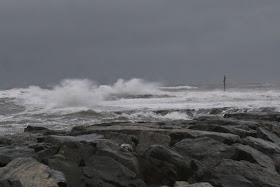A trip around the barrier islands around high tide on a Nor'easter certainly helps to demonstrate just how fragile our coastlines are and just how important it is to understand how these dynamic, natural systems work, such that we can protect both ourselves and the natural world to the best of our abilities. Certainly, the value of the wave-absorbing sand dunes along the coast was clear to see as rising waters washed right across Stone Harbor Point, leaving a scattering of beachgrass-topped, dune islands. Nummy's Island had an unfamiliar look too, as waves lapped at both sides of the road running across its middle. Many years ago, before we knew any better, the natural dunes at Cape May Point were deliberately removed, to allow the nouveau riche of the time to enjoy splendid views of the bay from their homes. After a number of disastrous floods - at least in part as a result of this beach removal - the dunes were replaced and the lesson learned.
The weather is likely to stay blustery for the next couple of days at least so it will be interesting to see what comes our way; with the Avalon Seawatch count hovering around 960,000 for the year, it would be nice if we can have a good run of birds over the coming week and see the magical one million figure reached - we'll keep you posted!
The 8th Avenue jetty was completely submerged at high tide today, with just the post at the far end sticking out of the turbulent waters [photo by Mike Crewe].
The road to the bridge across Townsend's Inlet is closed at present, which was a good thing as the storm surge pushed waves high over the breakwater and onto the road [photo by Mike Crewe].
Avalon can be a very different place in the winter to the tourist-filled resort it becomes in summer. Streets on the backbay side of the barrier islands - such as here at 23rd and Dune - can become inundated with saltwater during high storm surges [photo by Mike Crewe].
Sand dunes absorb a lot of the storm force that pushes onto land during a Nor'easter, but the beaches can be a dangerous place at this time [photo by Mike Crewe].
If you fancy birding in less exposed locations, the two Ross's Geese were still feeding contentedly beside the entrance to the Cape May Ferry Terminal [photo by Mike Crewe].
Wet woods at this time of year can be worth checking for Rusty Blackbirds - these four were part of a flock of 15 or so in the Red Maple swamp at the Rea Farm on Sunday. Rusty Blackbird populations are showing a worrying long-term downward trend and keeping accurate notes of observations of this species will add to our knowledge and perhaps help us to understand what is going on [photo by Mike Crewe].






No comments:
Post a Comment